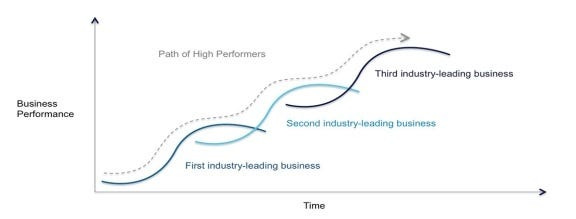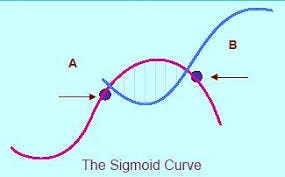Jumping the curveWhy the boldest founders don’t just ride the S-curve—they leap to the next one before everyone else sees the drop coming.The changes happening around would be the most challenging thing for all existing businesses. The only constant thing is “change”. The changes are all-pervasive, and no business is immune to them. In today’s fast-paced world, success often depends on how quickly your business can adapt to changing conditions. How well-versed are you, ready to pivot when the market changes? In the world of innovation, an S-curve explains the common evolution of a successful new technology or product. At first, early adopters provide the momentum behind uptake. A steep ascent follows, as the masses swiftly catch up. Finally, the curve levels off sharply, as the adoption approaches saturation. High performance is defined by companies that execute repeated climbs and jumps of the S-curve. Origins “Jumping the curve” is a saying that has been around for a few decades. It is attributed to the Irish philosopher and management futurist Charles Handy, who said that companies need to become aware of the sigmoid curve. The sigmoid curve (or S Curve) is the naturally occurring sloping line that Handy used to show that “companies will come to a natural end if they don’t re-create themselves during good times What does it take to jump the curve? You jump to the next curve by breaking old patterns of thinking and behaving. If you keep doing what you have been doing, you’ll keep getting what you have been getting.” To achieve different outcomes, you need to approach things differently. Guy Kawasaki, while discussing “The Art of Innovation” at TEDxBerkeley, advises startup founders about the matter of perspective when it comes to new opportunities. He says, “The perspective is to jump curves and not to stay on the same stupid curve that you’re on while trying to do things 10% better.” A classic example he elaborates on is that of the ice business. In this example, he points out how the ice-making business transformed over the past century from being ice harvesters to ice factories and then to refrigerators. The very interesting story about all of these curves is that none of the organizations that were ice harvesters became ice factories, and ice factories did not become refrigerator companies, because most companies define themselves in terms of what they do, not the benefits they provide. If you define yourself as we cut blocks of ice out of lakes, you remain an ice harvester. If you define yourself as freezing water centrally, you remain an ice factory. If you define yourself as making a mechanical gadget called a refrigerator, then you stay on the refrigerator curve. The way to jump the curve is to define yourself from the point of view of the benefits that your users get, as opposed to what you currently do. No one can predict the future, but Jack Uldrich can help you prepare for it. Jack Uldrich is a futurist who helps organizations gain the critical foresight they need to create a successful future. His work is based on the transformation principles of unlearning — or freeing yourself from obsolete knowledge and assumptions — as a strategy to survive and thrive in an era of unparalleled change. In this video, he talks about the importance for entrepreneurs to understand the concept of Jumping the Curve. He says, if anything is growing exponentially, and if nine technologies are growing exponentially, you can’t just go by the early trends, you have to follow it up with conclusions. The future does not increase linearly, but it grows exponentially.
Jumping the curve is inevitable Every business eventually faces the moment when growth plateaus and the old playbook stops working. This is the heart of the “S-curve” model: initial slow progress, a burst of rapid growth, and then a flattening as mastery—and market saturation—set in. As Whitney Johnson, cofounder of the Disruptive Innovation Fund, puts it in the Author Talks with Whitney Johnson: “Every time you start something new, you are at the base of the S-curve. Then you hit mastery... but because you’re no longer enjoying the feel-good effects of learning, you can get bored. This is the place where growth is actually slow.” The real challenge is recognizing when it’s time to leap—when to “jump the curve” and start climbing a new S-curve before stagnation sets in. This dilemma is at the core of Clayton Christensen’s classic, The Innovator’s Dilemma (Wikipedia, Book PDF). Christensen warns, “Good management principles... were precisely the reason large firms lost to up-and-coming businesses with disruptive technologies.” Incumbents, focused on perfecting what already works, often miss the moment to jump to new curves, leaving the door open for bold newcomers to redefine the game. As Paul Nunes explains in Jumping the S-Curve, “What matters is not just climbing your current S-curve... but making the moves you must make on the way to your next business—that is, making the jump to your future S-curve.” When do you jump the curve? If we view the first curve as a technology beginning to die out, and the second curve as a newer and more promising alternative, their first point of intersection shows continued improvements to the old system alongside the short-term upstart costs of investing in new methodologies. The best time to change is therefore when there is no immediate benefit to doing so, whereas sticking with successful practices eventually ensures their failure. Lessons for startups In today’s environment, there are rapid changes happening everywhere — markets, and technologies, and that continues to build a big challenge for a startup founder. As a founder, the most critical skill that you probably need today, irrespective of the startup stage, is to be able to jump your curve, generate a huge number of ideas, run efficient experiments to test assumptions underlying those ideas and launch new businesses as quickly as possible. This can happen by seeing and pursuing the “big enough” market insights that can take a startup business to the top of an industry and by creating a strategy “from the edge” to find and capture the next winning business idea.
Jumping the curve is not just relevant for the startups already in business, but also for wannabe founders who are looking for the next business idea! This skill is one of the core skills of entrepreneurship today. Invite your friends and earn rewardsIf you enjoy Startup-Side , share it with your friends and earn rewards when they subscribe. |
Monday, July 7, 2025
Jumping the curve
Subscribe to:
Comments (Atom)
Discipline Is Overrated. Spontaneity Is Underrated. Founders Need Both.
A reflective thought on why early certainty feels responsible for founders, how it quietly limits optionality, and why adaptability matters ...
-
kyungho0128 posted: "China's crackdown on Bitcoin (BTC) mining due to energy consumption concerns is widely regarded as...
-
Crypto Breaking News posted: "Mikhail Fedorov, Ukraine's Deputy Prime Minister and the head of the country's Minist...
-
admin posted: " A major British bank, Natwest, has put a limit on fund transfers to crypto...





